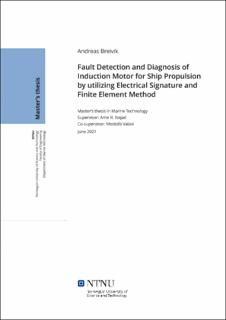| dc.contributor.advisor | Nejad, Amir R. | |
| dc.contributor.advisor | Valavi, Mostafa | |
| dc.contributor.author | Breivik, Andreas | |
| dc.date.accessioned | 2021-09-24T16:57:29Z | |
| dc.date.available | 2021-09-24T16:57:29Z | |
| dc.date.issued | 2021 | |
| dc.identifier | no.ntnu:inspera:78668897:49991909 | |
| dc.identifier.uri | https://hdl.handle.net/11250/2781526 | |
| dc.description.abstract | Induksjonsmotoren studert i denne masteroppgaven er en av to fremdriftsmotorer installert ombord polarforsynings- og forskningsfartøyet SA Agulhaus II og arbeidet er et bidrag til HealthProp-prosjektet (HealthProp 2020). HealthProp er et samarbeid mellom tyske, norske og sørafrikanske partnere og finansieres gjennom EU MARTERA-programmet. Prosjektets mål er å forbedre sikkerheten i arktiske og antarktiske operasjoner ved å utvikle et intelligent system for prediktiv overvåking, livsprognose og vedlikehold. Denne masteroppgaven presenterer en metode for deteksjon og diagnose av statorkortslutning, knekte rotorbarer og eksentrisitetsfeil i store induksjonsmotorer ved å analysere statorens strømfrekvensspektrum. Denne metoden har vist seg å være vellykket i tidligere forskningsarbeid. Det nye i denne oppgaven inkluderer modellering av de ulike feilene med FEM analyse. For å forstå hvordan de forskjellige feilene påvirker induksjonsmotorens strømspekter, presenteres virkemåten og egenskapene til motorens strømspekter. For å studere effekten av de forskjellige feilene ble det utført simuleringer av time-stepping finite element (TSFE) på en 2D-modell av induksjonsmotoren. Finite element-metoden ble brukt til å utføre dynamisk simulering, noe som fører til mer presise resultater enn andre modeller, ettersom den virkelige geometrien og viklingsutformingen til maskinen brukes. De forskjellige feilene er modellert for å representere en reell feil ved å modifisere modellen til en frisk motor. Modellen er basert på parameterne til induksjonsmotoren som brukes til fremdrift ombord på SA Agulhaus II. De tre feilene ble modellert med ulik grad av alvorlighetsgrad for å analysere effekten av en utviklende feil og om feilen kunne oppdages på et tidlig stadium. Oppgaven konkluderer med at den foreslåtte metoden potensielt kan oppdage og diagnostisere de forskjellige feilene som er undersøkt. Basert på den nye metoden i det utførte arbeidet, bør det utføres flere simuleringer for forskjellige lastprofiler. Feilmodelleringen og resultatene bør verifiseres med reelle data fra polarforsynings- og forskningsfartøyet SA Agulhaus II som neste trinn i utviklingen av en digital tvilling av fremdriftssystemet. | |
| dc.description.abstract | The induction motor studied in this thesis is one of two propulsion motors installed onboard
the polar supply and research vessel SA Agulhaus II and the work is a contribution to the
HealthProp Project (HealthProp 2020). HealthProp is a collaboration between German, Norwegian and South African partners and is funded through the EU MARTERA programme. The
project aims to improve safety in Arctic and Antarctic operations by developing an intelligent
predictive monitoring, life prediction and maintenance system.
This mater thesis presents a method for detection and diagnosis of stator short circuit, broken
bar and eccentricity faults in large induction motors by analyzing the stator current frequency
spectrum. This method has proven successful in past research. The novelty of the work done in
this thesis includes modelling of different faults with Finite Element Method (FEM) analysis.
To understand how the different faults affect the current spectrum of the induction motor, the
working principle and characteristics of the current spectrum of the motor are presented.
To study the effect of the different fault conditions, time-stepping finite element (TSFE) -
simulations were performed on a 2D model of the induction motor. Finite element method
was used to perform dynamical simulation, which leads to more precise results than other
models, as the reel geometry and winding layout of the machine are used. The different faults
are modeled to represent real faults by modifying the model of a healthy motor. The model is
based on the parameters of the induction motor used for propulsion onboard SA Agulhaus II.
The three faults were modeled with different degree of fault severity to analyze the effect of a
developing fault and if the fault could be detected at an incipient stage.
The thesis concludes that the proposed method can potentially detect and diagnose the different faults studied. Based on the novelty of the work performed, more simulations should
be performed for different load profiles. The fault modelling and results should be verified
with real data from the polar supply and research vessel SA Agulhaus II as the next step in
developing a digital twin model of the propulsion system. | |
| dc.language | eng | |
| dc.publisher | NTNU | |
| dc.title | Fault Detection and Diagnosis of Induction Motor for Ship Propulsion by utilizing Electrical Signature and Finite Element Method | |
| dc.type | Master thesis | |
